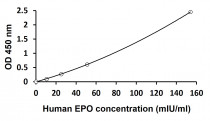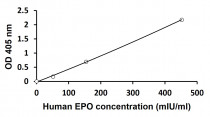ARG80825
Human EPO ELISA Kit
Human EPO ELISA Kit for ELISA and Human
Cancer kit; Cell Biology and Cellular Response kit; Developmental Biology kit; Metabolism kit; Signaling Transduction kit
Overview
| Product Description | ARG80825 Human EPO ELISA Kit is intended for the quantification of Erythropoietin (EPO) in human serum. With the advent of the administration of recombinant erythropoietin as a biologic therapy to increase red blood cell mass, an erythropoietin assay may be used also to aid in the prediction and monitoring of response to recombinant erythropoietin treatment in persons with anemias. |
|---|---|
| Tested Reactivity | Hu |
| Tested Application | ELISA |
| Target Name | EPO |
| Conjugation | HRP |
| Conjugation Note | Substrate: TMB and read at 450/405 nm |
| Sensitivity | 1.1 mIU/ml |
| Sample Type | Serum. |
| Standard Range | 10.5 - 154 mIU/ml (450 nm) 51 - 452 mIU/ml (405 nm) |
| Sample Volume | 200 µl |
| Alternate Names | MVCD2; EP; Epoetin; Erythropoietin |
Application Instructions
| Assay Time | 2 h, 30 min (RT) |
|---|
Properties
| Form | 96 well |
|---|---|
| Storage Instruction | Store the kit at 2-8°C. Keep microplate wells sealed in a dry bag with desiccants. Do not expose test reagents to heat, sun or strong light during storage and usage. Please refer to the product user manual for detail temperatures of the components. |
| Note | For laboratory research only, not for drug, diagnostic or other use. |
Bioinformation
| Database Links | |
|---|---|
| Gene Symbol | EPO |
| Gene Full Name | erythropoietin |
| Background | Erythropoietin (EPO) is a heavily glycosylated protein with a molecular weight of about 30,000 - 34,000 Daltons. Human EPO is a polypeptide consisting of 165 amino acids, containing one O-linked and three N-linked carbohydrate chains. The recombinant EPO is a good substitute for the native protein for use in an immunoassay. Serum EPO levels are dependent on the rate of production and the rate of clearance of the protein. Ninety percent of EPO is produced in the peritubular cells of the adult kidney in response to a decrease in tissue oxygenation. There is evidence indicating that the protein on these cells which detects oxygen saturation of the blood is a heme-containing moiety. As the pO2 of the plasma, a function of the hematocrit decreases, EPO concentration will increase. There are also observations suggesting that normally there is an inverse correlation between serum EPO levels and red blood cell mass. Quantitation of serum erythropoietin concentration serves as a diagnostic adjunct in determining the cause of anemia or erythrocytosis. Aplastic anemia, hemolytic anemia and anemia due to iron deficiency all result in serum EPO elevation. Whereas, EPO levels in patients with secondary anemia due to renal failure and other disorders such as acquired immune deficiency syndrome (AIDS) are generally inappropriately low for the degree of anemia. This is mostly likely caused by an impaired ability of the diseased kidney to produce adequate quantities of EPO. Low concentrations of EPO may give an early warning of kidney transplant rejection. EPO also can be used to monitor AIDS patients undergoing Zidovudine (AZT) therapy. An increased concentration of EPO verifies that anemia associated with AZT therapy is due to red cell hypoplasia or apliasia. Polycythemia rubra vera, or primary erythrocytosis (an increase of red blood cell mass) results from unstimulated over production of erythrocytes. Hence, the increase in the hemoglobin causes decreased production of EPO, which results in subnormal levels of serum EPO. Secondary polycythemias, which are also characterized by an increase in the total red blood cell mass, occur as a physiological response to elevated levels of circulatory EPO caused by tissue hypoxia. The hypoxia may be due to such factors as pulmonary fibrosis, cardiovascular disease, prolonged exposure to high altitude, abnormal forms of hemoglobin or drug treatment. Some tumors produce EPO and, in these cases, EPO may be used as a tumor marker to monitor the effectiveness of treatment. |
| Highlight | Related products: EPO antibodies; EPO ELISA Kits; New ELISA data calculation tool: Simplify the ELISA analysis by GainData |
| Research Area | Cancer kit; Cell Biology and Cellular Response kit; Developmental Biology kit; Metabolism kit; Signaling Transduction kit |
Images (2) Click the Picture to Zoom In
-
ARG80825 Human EPO ELISA Kit standard curve image
ARG80825 Human EPO ELISA Kit results of a typical standard run with optical density reading at 450 nm.
-
ARG80825 Human EPO ELISA Kit standard curve image
ARG80825 Human EPO ELISA Kit results of a typical standard run with optical density reading at 405 nm.
| Title | Download Link |
|---|---|
| ARG80825 Human EPO ELISA Kit User's manual |
 Download Download
|







